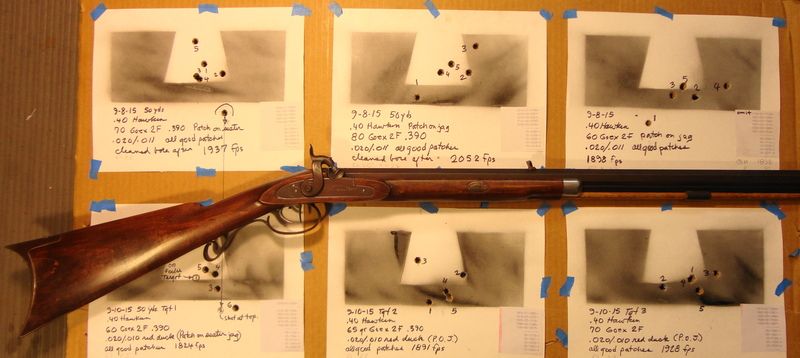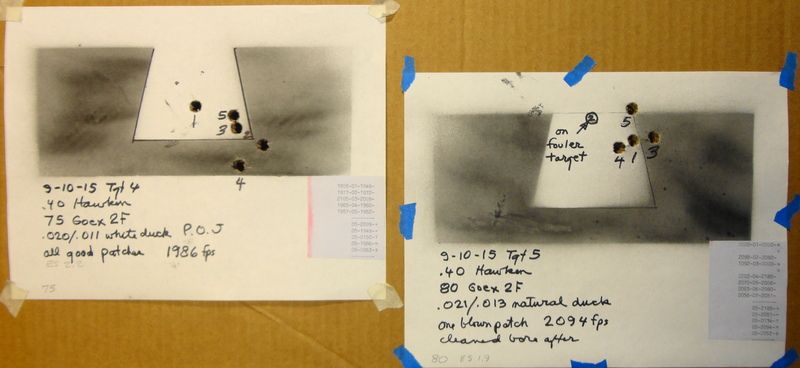I have gone to heavy patching as Daryl recommended and polished the crown even more. This has eliminated the blown patches. I still have shots out of the group but now know they are due to my use of a muzzle rest. I need to modify it so it holds the muzzle so it cannot shift when I shoot. (The composite target groups were shot with a forend rest). I made weight-corrected measures from cartridge cases for 60, 65, 70, 75 and 80 grains of Goex 2F. Using an older (steel, Minden, LA) can of Goex, I found that 80 grains volume weighed 5 grains more than my plastic bottle Goex 2F. Made a corrected 80 grain measure.
Patches were red cotton duck from Wal Mart (several vears ago), which miked .020 with a spindle micrometer and ratchet. (Got it from Herters about 1970 for $5.00, made in West Germany). When I twisted the barrel to compress the cloth, I got .010. A dial caliper read .020 and then with the blades squeezed between my fingers, .018. I always use a compressed spindle reading, for that is what happens when the ball is seated. Just went to Wal Mart to find more of that red duck so I could post what it is. Found only some "ruby" (I think) made in China cotton that miked .012 ratchet and .007 compressed. I tried other fabrics they had, all about the same. Did not get to Jo-Anns yet.
Shot 5-shot progressive charge groups (on 9-10, top row is 9-8) with a damp cleaning patch on the seater jag. No other cleaning, except at the end. 60, 65, 70 and 75 grains have the same point of impact, but 80 grains impacts higher. Shot some .023/.013 yellow awning (Wal Mart couple of years old) on the last target, but it is too hard to load. All balls for all charges were seated with a short starter and mallet. Could have used my hand, but a mallet is easier.
Though these groups look large, the best three shots of each target shown, 27 shots, averaged 1.08" extreme spread. The composite target from 8-23-15 had the best 3 of each 7 groups averaging 1.05". Thus 48 shots with all these different powder charges and patches in about one inch at 50 yards. (You can hit CONTROL and the + sign to enlarge the photos).


(Shot #2 of the 80 grain charge loaded so hard that I shot it on the fouler target).

I ran out of red duck so had to use other patches the last three targets. This target is the best I have for my eyesight now. I tried Marcruger's target, but that required construction instead of a template and spray paint, and was not as good for me. I am getting about all of this rifle I want, got others to build. Have to figure what to do with it. May give it to a nephew is Iowa, a hunter. May sell it, now that I have figured out how to shoot it. Got an elk hunt in October where I will use my .54 Bridger Hawken.

